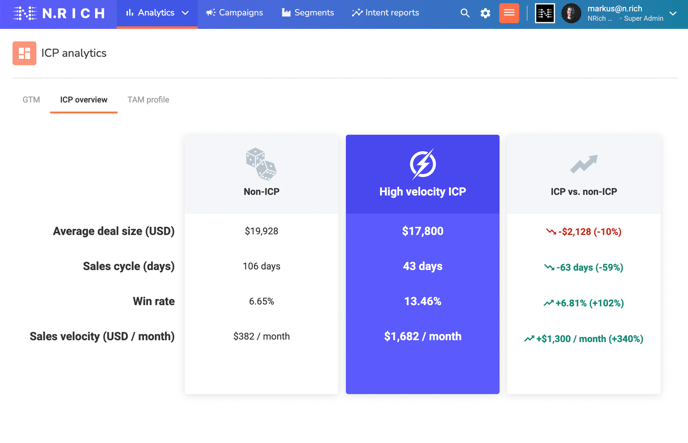Sales Velocity ICP Configuration
The article is currently being updated. Please get in touch with your CSM for more information.
Purpose
Sales Velocity Ideal Customer Profile (ICP) is used to determine the profile of accounts that are most likely to generate revenue fastest, i.e. accounts that have the highest possible sales velocity. As a result, when you focus your Sales and Marketing Go-To-Market activities on these accounts, they will result in the best possible Return On Investment available.
How does the algorithm work?
The algorithm uses AI with your CRM opportunity data, especially won opportunities (won amount and sales cycle) as well as lost opportunities (win rate) to identify the firmographic parameters (e.g. industry, company size, country) shared by the high-velocity accounts. Sales Velocity ICP algorithm uses this data to identify the firmographic profile of accounts that are expected to generate the maximum sales velocity based on the following formula:

-
Won Value refers to the monetary value of won opportunity.
-
Win Rate refers to # of won opportunities / # of all closed opportunities (won + lost + other closed).
-
The Sales Cycle refers to the time in days from the opening to the winning of the opportunity.
Once configured, the algorithm runs automatically every week, so the ICP scoring evolves as the opportunity data gets updated.
Outcome
Once the algorithm has been configured, you can find all the High Sales Velocity accounts in a special segment. Additionally, all the accounts you can find on N.Rich are going to have Sales Velocity rating (Low, Medium, High) and you can find under analytics details of your Sales Velocity ICP accounts:
-
Various metrics of your opportunity data comparing ICP to non ICP (GTM tab)
-
Sales Velocity metrics of ICP compared to non-ICP accounts (ICP overview tab)
-
The firmographic profile of the ICP accounts (TAM Profile tab)
 Example of ICP overview table on N.Rich
Example of ICP overview table on N.RichConfiguration
Once your CRM has been integrated with N.Rich, the Sales Velocity ICP will be configured by the N.Rich team. In order to ensure that the Sales Velocity ICP data is valid, there are a few key questions that need to be answered:
|
Question |
Required answer |
Explanation |
|---|---|---|
|
What is the earliest created time of opportunity that is acceptable? |
Define the time range, or no limits. Default: past 12 months |
If GTM motion evolves, it makes sense to limit the data to current GTM instead of all time. If GTM is static, there is no need to limit the range. |
|
Should won opportunities with no value be omitted? |
Yes / No - default: Yes |
Won opportunities with no value will decrease the output Sales Velocity ICP quality. |
|
Should there be a minimum won value for acceptable opportunities? |
Minimum value needs to be defined - default: not applicable |
Sometimes it is justified to focus ICP only to larger clients for example. |
|
Should won opportunities with shorter than 30 days sales cycle be omitted ? |
Yes / No - default: Yes |
Shorter sales cycle than 30 days usually, but not always points out to invalid data in CRM and this is why it’s recommended to omit them. |
|
Should opportunities with certain properties be omitted? |
Properties and their values need to be defined - default: Not applicable |
Sometimes there are different kinds of opportunities in CRM that may not be comparable, e.g. ones created by own team vs. those created by channel. |
|
Should some countries, industries or company sizes be omitted from the won opportunities? |
Countries / industries and/or company sizes need to be defined - default: Not applicable |
Sometimes it is known that some types of clients are not preferrable, for example because of high cost of maintaining the relationship. |
|
Should certain countries be included to the output that are not part of the input data (won opportunities) |
Countries need to be defined - default: not applicable |
Sometimes there is a decision to focus on some markets that have not been historically targeted. In such case the algorithm can use the existing opportunity data and apply it to the target market, even if there is no data available for that market. |